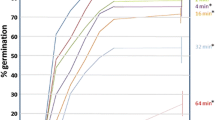Summary
1) Some aspects of transplantation of embryo pieces of one species, into the embryo of an other one were discussed, as well as the grafting of an embryo on the endosperm of other varieties, species and even genera (vegetative hyberidization).
2) Deep hereditary changes were observed, as well as an incompatibility (negative tropism) to assimilate and to fuse between the embryonic tissues of different species.
3) But a positive tropism with a complete assimilation of the tissue can also be observed in all those cases, when the grafted endosperm, belonged to the same species as the one of the transplanted embryo piece.
4) This method should be extended in order to produce oil seed crops and particularily soja beans, ripening in northern long day regions (change from short day to long day photoperiodism).
5) Ultrasonic vibrations could be usefully applied to improve this grafting method.
Resume
1) Quelques aspects de transplantation d'un fragment d'embryon d'une espèce, dans celui d'une autre, ont été discutés, ainsique le gréffage d'un embryon, sur les réserves nutritives (endosperme) d'autres variétés, espèces et mêmes genres (hybridation végétative).
2) Des changements héréditaires profonds ont pu être observés, ainsiqu'une incompatibilité (tropisme négative) de s'assimiler et de fusionner entre les tissus embryonaires de différentes espèces.
3) Quand-même un tropisme positif, accompagné d'une assimilation complète des tissues, put être observé dans tous ces cas, ou la réserve nutritive (endosperme) appartenait à la même espèce que le fragment transplanté.
4) Cette méthode devrait être approfondie pour pouvoir produire des plantes oléagineuses, en particulier du soja, qui puisse mûrir dans des régions nordiques aux jours longs, pendant la saison de croissance (changement d'un phototropisme de jours courts à celui de jours longs).
5) Un traitement aux Ultra-Sons pourrait être avantageusement appliqué afin d'améliorer cette méthode.
Similar content being viewed by others
Bibliographie
Fischnich, O. &Heilinger, F., 1958: Ultraschall u. seine Anwendung in Biologie u. Landwirtschaft.Ber. der Oberhess. Ges. für Naturheilkunde zu Giessen Neue-Folge, 29,94–99.
Ghisleni, P. L. 1955/56: Contributo alla conescenza degli effecti degli ultrasuoni sui vegetali superiori.Ann. dell' Acad. Agr. di Torino, 90,1–43.
Heilinger, F., 1958: Fermentaktivierung durch Ultraschall.Beitr. Biol. Pflanzen. 34, 3,457–66.
Kalinine, F. L., 1948: Winter wheat development on summer wheat endosperm.Dok. Acad. Sci. S.S.S.R.
Keiffer, L., 1953: Einwirkung von Ultraschallwellen auf Pflanzen.Dissertation, T. M. München 4/461.
Mathon, Cl. Ch., 1951: La „greffe” embryonnaire des graminées.Bull. Soc. Linéenne de Lyon, 23, 15–13.
Obolensky, G., 1957: Divers effects of ultrasonic vibrations in Biology.Année biol. 33,465–521.
Obolensky, G., 1958: The use of Ultrasonics in cellulose production from straw, grasses and similar material.Qual. Plant. Mater. Veg., 5, 1–2,134–144.
Obolensky, G., 1958: Influence des Ultrasons sur l'augmentation des taux de vanilline et d'oléorésines dans les gousses de Vanille.Qual. Plant. Mater. Veg., 5, 1–2,45–63.
Obolensky, G., 1959: Relations entre les extractions ultrasonores et les fréquences utilisées.Ind. Alim. Agr., 76, 2,111–114.
Popov, J. D., Karabashev, N. &Karabasheva, T., 1955: The enzyme chemical activity of seeds on the application of ultrasonics.Docl. Acad. Sci. Bulgarian, 8,65–68.
Rausher, V. &Trinka, A., 1959: Untersuchungen über die durch Ultraschall hervorgerufene Sofortänderungen in der Zelle.Biol. Plant., Praha (in print).
Stettler, J., Wolters, K. &Straaten, von der J., 1957: Einfluss von Ultraschall auf die Keimung von Saatgut u. die Entwicklung der Pflanze sowie Prüfung der Verwendungsmöglichkeit des Ultraschalls in der Phytopathologie.Nachrichtenblatt des deutschen Pflanzenschutzdienstes, 9, 11,166–170.
Straaten, J. von der, 1958: Einfluss von Ultraschall und Ultraschall in Verbindung mit Wirkstoffen auf Keimung u. weitere Entwicklung einiger Kulturpflanzen.Beitr. Biol. Pflanzen, 34, 2,325–358.
Warnecke, E., 1953: Bakteriologische Ultraschallstudien.Z. Hygienie 138, 17 and 953.
Rights and permissions
About this article
Cite this article
Obolensky, G. Grafting of plant embryos and the use of ultrasonics. Plant Food Hum Nutr 7, 273–288 (1960). https://doi.org/10.1007/BF01104094
Published:
Issue Date:
DOI: https://doi.org/10.1007/BF01104094




